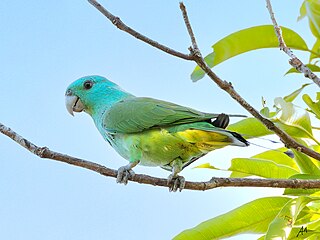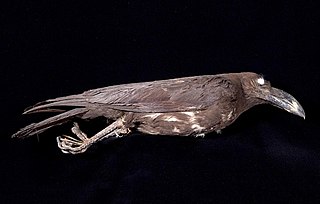
The yellow-rumped cacique is a passerine bird in the New World family Icteridae. It breeds in much of northern South America from Panama and Trinidad south to Peru, Bolivia and central Brazil. However, they have been sighted as far north as Nayarit state in Mexico.

The subtropical cacique is a passerine bird species in the New World family Icteridae. It breeds in the lower reaches of the northern Andes.

The blue-headed racket-tail, also known as the Palawan racket-tail and locally as kinawihan, is a parrot found in the western Philippines around Palawan. The species was formerly considered conspecific with the blue-crowned racket-tail. It is locally known as 'kilit'. It inhabits humid lowland forest in small flocks. It is threatened by habitat destruction and limited trapping for the cage-bird trade.

The wattled guan is a species of bird in the family Cracidae. It is a fairly large black cracid with blue-based, black-tipped beak and a long, red-and-yellow wattle.

The yellow-breasted tailorbird is a species of passerine bird formerly placed in the "Old World warbler" assemblage, but now placed in the family Cisticolidae. This species is endemic to Philippines on the islands of Bohol, Samar and Leyte. It is known for its bright color relative to other tailorbirds with a yellow body and a striking black head with a white spot under its chin. Its natural habitat is tropical moist lowland forests. It is threatened by habitat loss.

The lemon-throated leaf warbler is a species of Old World warbler in the family Phylloscopidae. It is endemic to the Philippines found on the islands of Luzon, Negros and Cebu.

The rufous coucal is a species of cuckoo in the family Cuculidae. It is found in Luzon and proximate islands in the Philippines. Its natural habitat is tropical moist lowland forest. It is threatened by habitat loss. Along with the Philippine coucal, Black-faced coucal and the critically endangered Black-hooded coucal, it is one of the 4 endemic coucals.
The grey-headed imperial pigeon is a species of bird in the family Columbidae. It is endemic to Sulawesi in Indonesia. Its natural habitats are subtropical or tropical moist lowland forests and subtropical or tropical moist montane forests.

The Ecuadorian cacique is a species of bird in the family Icteridae. It is found in Colombia, Ecuador, and Peru, where its natural habitat is subtropical or tropical moist lowland forest. A fairly common bird with a wide range, the IUCN has rated it a "species of least concern".

The solitary cacique or solitary black cacique is a species of bird in the family Icteridae.

The yellow-billed cotinga is a species of bird in the family Cotingidae. It is found in the Pacific lowlands of Costa Rica and Panama. Its natural habitats are subtropical or tropical moist lowland forest, subtropical or tropical mangrove forest, and subtropical or tropical moist shrubland. It is threatened by habitat destruction.

The casqued cacique, formerly the casqued oropendola, is a species of bird in the family Icteridae.

The brown-headed crow is a passerine bird of the genus Corvus in the family Corvidae. Endemic to Indonesia, it has a fragmented distribution in subtropical or tropical moist lowland forest and subtropical or tropical mangrove forest. It is threatened by habitat destruction and the IUCN has rated it as being "near-threatened".

The São Tomé fiscal, or Newton's fiscal, is a species of bird in the family Laniidae. It is endemic to São Tomé Island, São Tomé and Príncipe. It is 20 to 21 centimeters long. The bird is black above with a white shoulder-scapular bar. The São Tomé fiscal has a pale yellow chin, breast, belly, flanks vent and under tail. Its graduated tail has all black central tail feathers and an increasing amount of white on outer web from inner to outer tail feathers. The Lanius newtoni has a clear voice with a whistle tiuh tiuh often repeated and metallic tsink tsink audible over a long distance.

The masked fruiteater is a species of bird in the family Cotingidae endemic to Peru. Its natural habitat is subtropical or tropical moist montane forests on the eastern flanks of the Andes. Considering the bird's population size and its wide range, this species is classified by the IUCN as being of least concern.

The golden-naped woodpecker is a species of bird in the woodpecker family Picidae. The species is very closely related to the beautiful woodpecker, which is sometimes treated as the same species. The two species, along with several other species, are sometimes placed in the genus Tripsurus.

The yellow-footed honeyguide is a species of bird in the family Indicatoridae. It is found in Cameroon, Guinea, Liberia, Sierra Leone, Ivory Coast, Ghana and Nigeria. Its natural habitat is subtropical or tropical moist lowland forests. It is threatened by loss of its forest habitat.

The ashy-fronted bulbul is a member of the bulbul family of passerine birds. It is endemic to Palawan in the Philippines. Its natural habitat is tropical moist lowland forests. Until 2010, the ashy-fronted bulbul was considered as a subspecies of the olive-winged bulbul.

The diademed amazon is a parrot in the family Psittacidae formerly considered conspecific with the red-lored amazon. Amazona diadema is restricted to the state of Amazonas in north-western Brazil.

The Mindoro racket-tail is a species of parrot in the Psittaculinae family. It was formerly considered conspecific with the blue-crowned racket-tail. It is endemic to the island of Mindoro in the Philippines and it occurs in tropical moist lowland forest. It is threatened by habitat loss and trapping for the cage-bird trade.




















